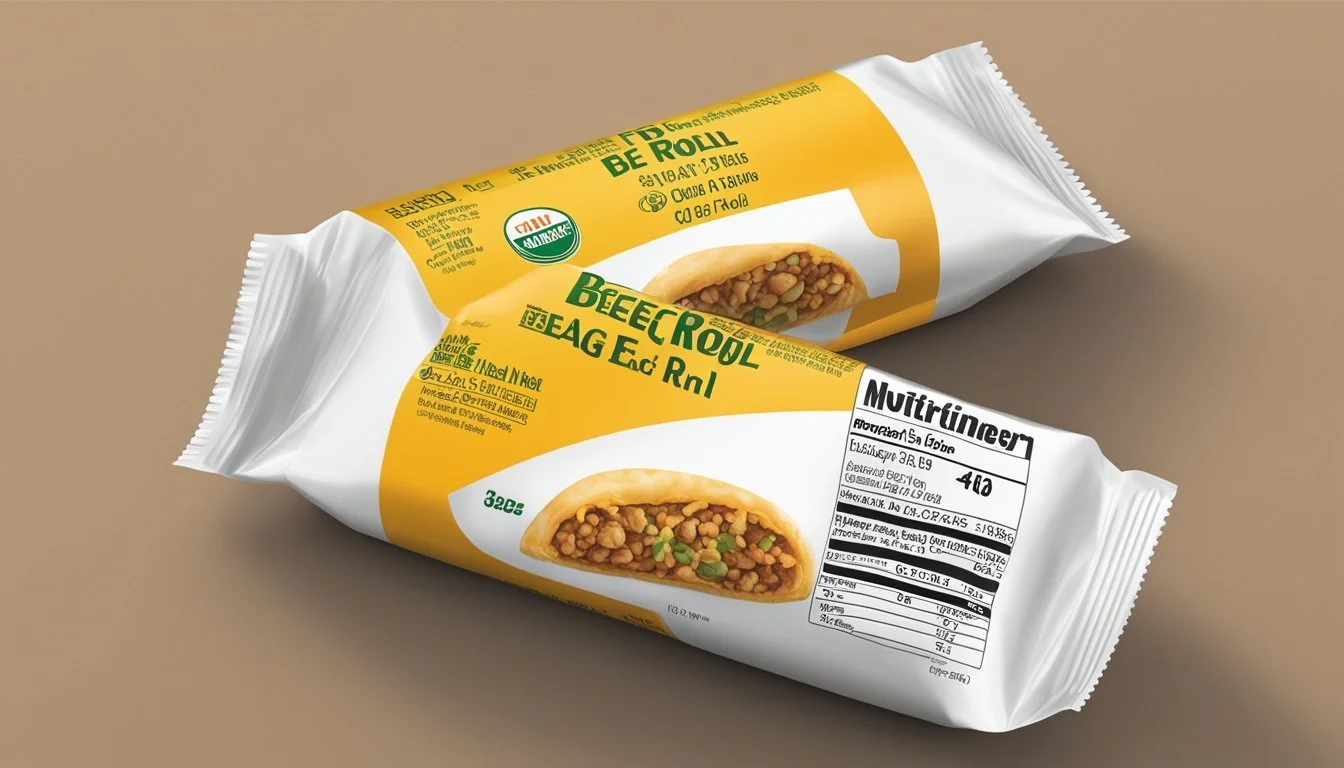How Long Do Beef Egg Rolls Last?
Tips for Maximizing Freshness
Storing beef egg rolls properly ensures they remain fresh and safe to eat. At room temperature, cooked beef egg rolls will only last for about 2 hours, while uncooked egg rolls should not be left out for more than 1 hour. When refrigerated, cooked egg rolls can last for 3-4 days, and uncooked ones can be kept for up to a week.
For those who prefer preparing batches in advance, the freezer is an excellent option. Both cooked and uncooked beef egg rolls can stay fresh for up to 6 months in the freezer. Using airtight containers or heavy-duty freezer bags extends their longevity and helps maintain their taste and texture.
Whether prepared for a quick snack or a party, knowing how long beef egg rolls last and the best storage methods can enhance your culinary experience. Taking these steps ensures that every bite is not only delicious but safe as well.
Understanding Egg Rolls
Egg rolls are a popular appetizer featuring a crispy exterior that encases a variety of fillings. They offer a rich combination of flavors and textures and can vary widely in ingredients and preparation methods.
Ingredients and Recipe
Typical egg rolls consist of egg roll wrappers filled with a seasoned mixture. For beef egg rolls, ground beef, cabbage, and onion are common ingredients. Additions like minced garlic, carrots, soy sauce, black pepper, and ginger enhance the flavor.
The preparation involves cooking the ground beef until brown and then mixing it with chopped cabbage and vegetables. The mixture is seasoned with garlic powder and a pinch of sugar. This filling is then spooned onto wrappers, folded, and sealed before frying until golden brown.
Variations and Types
Egg rolls come in numerous variations, each bringing a unique twist to the traditional recipe. While beef egg rolls are popular, other variations include chicken, pork, and even vegetarian options. These alternative fillings often incorporate fresh vegetables like mushrooms and bell peppers, providing diverse flavor profiles.
Another variation to explore is the seasoning, particularly regional spices and sauces. For instance, using hoisin sauce or a dash of chili flakes can introduce a different taste. Spring rolls from Chinese cuisine are a lighter, often healthier version, using thinner wrappers and sometimes skipping the deep frying.
Proper Storage Techniques
To maximize the shelf life and maintain the quality of beef egg rolls, they should be stored correctly. The methods of refrigeration, freezing, and using airtight containers are essential.
Refrigerating Egg Rolls
Refrigeration is key to preserving the freshness of beef egg rolls. The temperature of the refrigerator should be set between 35°F (1.6°C) and 40°F (4.4°C). Beef egg rolls should be placed on a shelf where they won’t be easily bumped or moved.
In the refrigerator, beef egg rolls can be stored for up to 3 to 4 days. Beyond this period, the texture and taste may degrade, and the risk of bacterial growth increases.
Freezing Egg Rolls
For longer storage, beef egg rolls can be frozen. First, place them in a single layer on a baking sheet and freeze until firm. Once frozen, they should be transferred to a freezer bag or an airtight container.
When freezing, ensure the temperature is set to 0°F (-18°C) or lower. This way, the egg rolls can last up to 3 months without significant loss of quality. Proper packaging prevents freezer burn, which can affect texture and taste.
Airtight Containers Use
Using airtight containers is crucial in maintaining the quality of beef egg rolls, whether stored in the fridge or freezer. These containers prevent moisture loss and protect the egg rolls from other odors and contaminants.
If storing in the refrigerator, ensure the egg rolls are sealed tightly in a container or wrapped in plastic wrap. For freezing, plastic bags that are designed for freezer use or airtight containers will safeguard the egg rolls from freezer burn and moisture changes.
Proper packaging helps reduce the risk of cross-contamination and prolongs shelf life.
Shelf Life Determination
The shelf life of beef egg rolls varies based on storage conditions. Optimal freshness and safety are ensured by adhering to specific guidelines.
Refrigerated Shelf Life
When storing beef egg rolls in the refrigerator, it is important to keep them in an airtight container. The typical refrigerated shelf life for homemade beef egg rolls is 3 to 4 days. This duration ensures that the rolls maintain their texture and taste.
Store-bought beef egg rolls often have a longer shelf life. They can last up to a week, but it is crucial to check the expiration date on the label. Maintaining a refrigerator temperature of 35°F (1.6°C) to 40°F (4.4°C) helps preserve the quality.
Frozen Shelf Life
For longer preservation, freezing beef egg rolls is an effective method. Frozen beef egg rolls can last up to 2 to 3 months when properly sealed in a vacuum-sealed bag or an airtight container. This method significantly extends their shelf life compared to refrigeration.
Ensure the beef egg rolls are placed in the freezer at 0°F (-18°C) or colder. Labeling the packaging with the date of freezing can help keep track of their freshness and ensure they are consumed within the recommended time frame.
Factors Affecting Shelf Life
Several factors influence the shelf life of beef egg rolls. The initial freshness of the ingredients plays a crucial role. Ingredients that are near their expiration significantly reduce the final shelf life. Proper storage methods, such as using airtight containers, are essential to prevent moisture and air exposure, which can lead to spoilage.
The type of filling also impacts shelf life. For example, egg rolls with raw beef may spoil faster compared to those with cooked beef. Temperature fluctuations in the refrigerator or freezer can also affect quality and safety. Frequent opening of the storage unit can lead to temperature variations, accelerating spoilage.
By understanding these factors and adhering to proper storage guidelines, the shelf life and quality of beef egg rolls can be maintained effectively.
Signs of Spoilage
Identifying spoilage in beef egg rolls is crucial for ensuring food safety. Key indicators include visual and textural changes, distinctive odors, and alterations in taste. Monitoring these signs can help prevent the consumption of unsafe food.
Visual and Texture Changes
One of the first signs of spoilage in beef egg rolls is a change in appearance. Mold spots, often green or black, indicate that the egg rolls are unfit for consumption. Discoloration of the beef, turning from its natural color to brown or gray, suggests spoilage.
Texture also plays a significant role. Fresh beef egg rolls should feel firm and slightly crispy. A slimy texture on the surface of the egg rolls is a clear sign of bacterial growth and spoilage. Freezer burn, characterized by white or grayish patches, indicates that the food has been stored improperly and may have lost quality.
Odor Development
Off odors are one of the most unmistakable signs of spoilage in beef egg rolls. Fresh egg rolls typically have a pleasant, savory aroma. When they begin to spoil, they emit a foul, sour, or putrid smell. This odor results from bacterial activity breaking down the beef and other ingredients.
If the smell is strong and off-putting, it is a clear indicator that the egg rolls are no longer safe to eat. Checking for odors before consuming leftovers can prevent foodborne illness.
Taste Alteration
Taste is another critical factor in identifying spoiled beef egg rolls. While it is not advisable to taste food that already shows visual or olfactory signs of spoilage, sometimes changes in taste can be the final confirmation. Spoiled egg rolls may have a sour, bitter, or off taste due to bacterial and fungal activity.
Fresh egg rolls should have a balanced and savory flavor. If the taste deviates from the expected profile, it is best to discard the egg rolls to avoid any health risks.
Safe Consumption Practices
Proper handling and preparation are crucial to ensuring that beef egg rolls are both delicious and safe to eat. This involves adequate storage, careful handling of leftovers, and safe reheating practices.
Handling Leftovers
When it comes to leftover beef egg rolls, proper storage is key to maintaining both quality and safety. Cooked egg rolls should be placed in an airtight container or resealable bag and stored at a temperature between 35°F (1.6°C) and 40°F (4.4°C) to keep them fresh for up to 4 days.
It's important to use paper towels to absorb any excess oil or fat, which helps preserve the crispy texture. Always be mindful not to leave egg rolls at room temperature for more than 2 hours. Ensuring proper refrigeration minimizes the risk of bacterial growth and maintains the egg roll's tender and crispy texture.
Heating and Reheating
Reheating beef egg rolls correctly ensures they are just as tasty and safe to eat as when freshly cooked. Oven reheating is a popular choice, as it helps maintain crispness. Preheat the oven to 350°F (176.6°C) and bake the egg rolls for about 10-15 minutes until heated through and crispy.
Air fryers also provide an effective method. Set the air fryer to 350°F (176.6°C) and cook the egg rolls for 5-7 minutes. For those who prefer stove-top methods, using a skillet with a light layer of oil can yield good results. Cook on medium heat, turning occasionally to ensure even heating.
Avoid microwave reheating, as it can leave the egg rolls soggy. Proper reheating maintains the crispy texture and ensures the egg rolls reach a safe internal temperature for consumption.
Culinary Tips and Tricks
When making beef egg rolls, focusing on flavor and texture can transform this appetizer into a culinary delight. Consider the following tips for enhancing flavor and achieving a crispy texture.
Enhancing Flavor
To boost the flavor of beef egg rolls, start with high-quality ingredients. Ground beef should be lean yet tender, seasoned with soy sauce, garlic, ginger, and a dash of salt and pepper. Adding finely chopped onions and a splash of sherry can deepen the flavor profile.
A mixture of cabbage and carrots is often included for a fresh contrast. Stir-fry the vegetables briefly in olive oil or vegetable oil to maintain their crunchiness while infusing them with a touch of garlic powder and seasoned salt. Ensuring the beef mixture is well-drained before adding it to the egg roll wrapper prevents sogginess and enhances overall taste.
Achieving Crispiness
Crispiness is key to a perfect egg roll. For deep frying, heat about 3 cups of vegetable oil in a pan to 325 degrees Fahrenheit. Fry 4-5 egg rolls at a time, turning them occasionally to ensure an even golden-brown color.
For a healthier alternative, baking is effective. Preheat the oven to 400 degrees Fahrenheit. Arrange egg rolls on a baking sheet, brushing them lightly with oil. Bake for 15-20 minutes, flipping halfway through to achieve uniform crispiness. Using an air fryer is another method to get a crispy texture without excessive oil. Air fry egg rolls for around 5-7 minutes at 400 degrees Fahrenheit until they are crispy and heated through.
Nutritional Information
Beef egg rolls can be a flavorful addition to any meal, but it's important to understand their nutritional profile. This includes information on their caloric content and various health considerations such as fat, protein, and sodium levels.
Caloric Content
A typical beef egg roll contains around 113 to 222 calories, depending on the size and specific ingredients used.
Nutrient Amount (per 89g) Calories 222 Protein 7.37 grams Fat 11 grams (approx.)
The protein in beef provides muscle-building benefits, while the fat content varies based on cooking methods and additional ingredients. Notably, one egg roll with beef and pork offers about 113 calories, with 50% of those calories from fat, 33% from carbs, and 18% from protein.
Health Considerations
Beef egg rolls contain a variety of nutrients but also come with health considerations.
Fat: They typically have a notable amount of fat, approximating 50% of the caloric content.
Sodium: Ingredients like soy sauce can contribute to higher sodium levels, impacting those concerned with blood pressure.
Sugar: While not major, some recipes might include small amounts of sugar.
Carbs: They derive a third of their calories from carbohydrates, impacting those monitoring carb intake.
These considerations are crucial for people managing specific nutritional needs or dietary restrictions. Adjustments in preparation, such as using low-sodium soy sauce or baking instead of frying, can help make beef egg rolls a healthier option.
Creative Serving Ideas
Serving beef egg rolls can be a unique opportunity to pair them with a variety of side dishes and dipping sauces for a complete meal experience. From zesty sauces to cheesy accompaniments, the right pairing can elevate this savory appetizer to a delightful snack or dinner addition.
Side Dishes
Guacamole
Creamy guacamole pairs wonderfully with the crispy texture of beef egg rolls. The avocados, lime juice, and jalapenos in guacamole provide a zesty contrast that enhances the savory beef filling.
Asian Slaw
A fresh, tangy Asian slaw with cabbage, carrots, and a light sesame dressing complements the richness of egg rolls. Its vibrant crunch provides a refreshing balance to the fried appetizer.
Fried Rice
Serving beef egg rolls with fried rice makes for a satisfying meal. The variety of vegetables and a slightly sweet soy sauce glaze in fried rice enhances the savory beef filling.
Dipping Sauces
Spicy Sriracha Mayo
A blend of sriracha and mayonnaise adds a spicy, creamy element to beef egg rolls. This dipping sauce brings heat and tanginess, making each bite exciting.
Sweet and Sour Sauce
This classic sauce blends sweet and tangy flavors that work perfectly with the savory beef filling. It’s a popular choice that everyone loves, adding a balanced, flavorful touch.
Cheese Sauce
A warm cheese sauce can add a rich, indulgent twist to beef egg rolls. The combination of melted cheese with the beefy goodness creates a delightful snack or appetizer that's hard to resist.
Each of these suggestions ensures that your beef egg rolls are served with accompaniments that enhance their flavor profile while providing a balanced, enjoyable eating experience.










